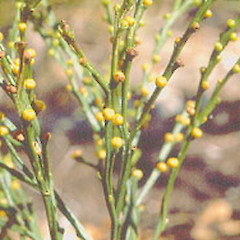Psilotum nudum
Common name
whisk fern, skeleton fork fern
Family
Psilotaceae
Flora category
Vascular – Native
Endemic taxon
No
Endemic genus
No
Endemic family
No
Structural class
Ferns
NVS code
The National Vegetation Survey (NVS) Databank is a physical archive and electronic databank containing records of over 94,000 vegetation survey plots - including data from over 19,000 permanent plots. NVS maintains a standard set of species code abbreviations that correspond to standard scientific plant names from the Ngä Tipu o Aotearoa - New Zealand Plants database.
PSINUD
Chromosome number
2n = 208
Current conservation status
The conservation status of all known New Zealand vascular plant taxa at the rank of species and below were reassessed in 2017 using the New Zealand Threat Classification System (NZTCS) – more information about this can be found on the NZTCS website. This report includes a statistical summary and brief notes on changes since 2012 and replaces all previous NZTCS lists for vascular plants.
Please note, threat classifications are often suggested by authors when publications fall between NZTCS assessment periods – an interim threat classification status has not been assessed by the NZTCS panel.
- Conservation status of New Zealand indigenous vascular plants, 2017 . 2018. Peter J. de Lange, Jeremy R. Rolfe, John W. Barkla, Shannel P. Courtney, Paul D. Champion, Leon R. Perrie, Sarah M. Beadel, Kerry A. Ford, Ilse Breitwieser, Ines Schönberger, Rowan Hindmarsh-Walls, Peter B. Heenan and Kate Ladley. Department of Conservation. Source: NZTCS and licensed by DOC for reuse under the Creative Commons Attribution 4.0 International licence.
2017 | Not Threatened | Qualifiers: SO
Previous conservation statuses
2012 | Not Threatened
2009 | Not Threatened
2004 | Not Threatened
Distribution
Indigenous. New Zealand: Kermadec Islands (Raoul Island), North Island (North Cape south to the southern shore of Lake Taupo and Tokaanu).
Habitat
Coastal to monatane. In the northern part of its range Psilotum is usually a local component of coastal forest where it grows on the forest floor, in rock piles and on cliff faces. It is also occasionally epiphytic on trees such as pōhutukawa (Metrosideros excelsa). On Raoul Island it is an abundant ground cover in the “dry” forest type on that island. In the North Island outside Northland and the Coromandel Peninsula, Psilotum becomes increasingly tied to geothermally active sites where it usually grows on cliff faces and warm soil around fumaroles. In the ignimbrite country north of Lake Taupo, and also along the western shore of Lake Taupo, Psilotum is at times a very common species growing in the joints of columnar ignimbrite. On the western shoreline of Lake Taupo in this type of habitat plants can grow very large, and they may grow right down into the flood-line where they are often associated with Lindsaea viridis. Around Auckland City Psilotum is a very common, though easily overlooked plant of stone walls (especially basalt or concrete retaining walls).
Detailed description
Epiphytic or terrestrial plants. Rhizome branching, short- to long-creeping, usually clumped. Aerial shoots 50–100–200–(900) mm, dark green, green or yellow depending on growing conditions, erect, firm of sometimes flaccid in shaded situations, branched repeatedly in different planes in the upper part. Branches prominently ribbed 3–7×, subterete in cross-section, to 4.5 mm diameter; stomata restricted to furrows between ribs. Sterile leaves 1.0–2.5 mm long, pale yellow (translucent toward apices), restricted to ribs, subspiral, terete. Synangia 1.5–2.0 × 2.0–2.5 mm, yellow, globular, partitioned in 3 segments.
Similar taxa
A very distinctive species unlike to be confused with any other fern. Psilotum is easily recognised by the almost distinctive broom-like growth habit, with numerous twiggy, coralloid, whip-like branches usually bearing bright yellow, globular synangia (which are always partitioned in 3). Psilotum could be confused with species of broom (Cytisus and Carmichaelia) as these sometimes grow in habitats favoured by Psilotum. They may be distinguished from Psilotum by the presence of trifoliolate leaves, flowers and/or seed capsules, and if sterile by non-rhizomatous growth habit, and the presence of a distinct root system bearing rhizobium nodules.
Flowering
Not applicable—spore producing
Flower colours
No flowers
Fruiting
Not applicable—spore producing
Propagation technique
Easily grown from rooted pieces. Best grown in a well drained substrate, planted in full sun. Once established very hard and drought tolerant. Psilotum makes an excellent pot plant, a use to which it is often put overseas.
Etymology
psilotum: From Greek psilos ‘bare’ or ‘naked’ referring to the apparent nakedness of the stems
nudum: Bare
Where To Buy
Not commercially available.
Attribution
Fact sheet prepared for NZPCN by P.J. de Lange (7 May 2011). Description adapted from Chinnock (1998).
References and further reading
Chinnock RJ. 1998. Psilotaceae. Flora of Australia 48, Ferns Gymnosperms and allied groups: 47–53. ABRS/CSIRO Victoria, Australia.
NZPCN Fact Sheet citation
Please cite as: de Lange, P.J. (Year at time of access): Psilotum nudum Fact Sheet (content continuously updated). New Zealand Plant Conservation Network. https://www.nzpcn.org.nz/flora/species/psilotum-nudum/ (Date website was queried)






